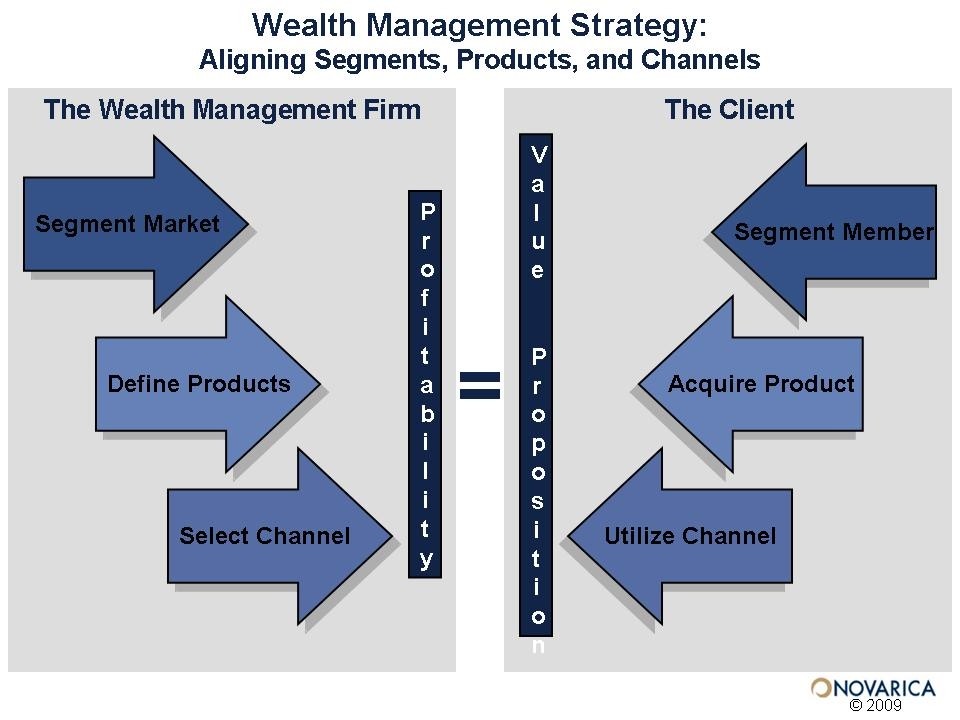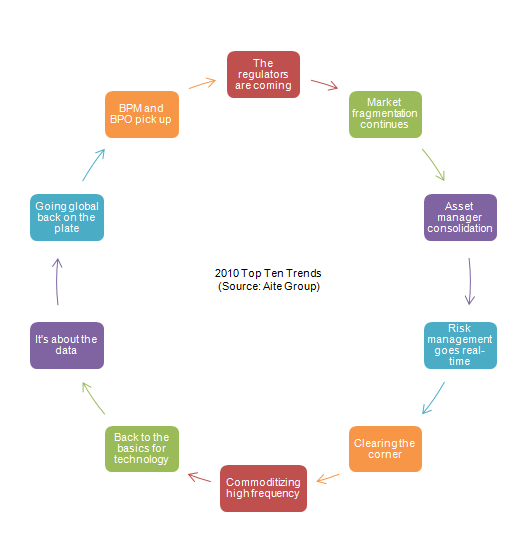Top 10 Trends in Wealth Management for 2012
Post on: 20 Июль, 2015 No Comment

Radical changes will continue to hit industry in 2012: Aite Group report
Wealth managers will see radical changes in their industry in 2012, says Aite Group in a new report.
Whither wealth management? The industry will continue to undergo radical changes that began in 2008, according to a detailed, 30-page Aite Group wealth management report released Friday.
In a report that identifies the top 10 trends that Aite foresees for wealth managers in the coming year, the Boston-based research and advisory firm warns that many of those trends will affect business models, profitability pressures, investor requirements and more.
Wealth management firms will be required to quickly and frugally rethink the way they do business in order to be successful in a challenging market environment, says Aite in the introduction to its Top 10 Trends in Wealth Management, 2012 impact note.
Here are the Top 10 wealth management trends to expect in 2012:
1. Market Reshuffle, Continued
Breakaway brokers, acquisitions by broker-dealers and private equity firms and changes in how advisors and investors approach control over their money will affect the market in 2012, Aite says in its wealth management report.
At the beginning of the crisis in 2008, Merrill Lynch and Wachovia Securities had to agree to be acquired, while Morgan Stanley and Smith Barney merged. Given that these four firms represented around one-third of brokerage and advisory assets in the United States, a major portion of the wealth management market has been in transition ever since, Aite notes.
The bulk of financial advisors who decided to break away from their firm mostly comprised smaller producers who were unable to obtain a lock-in contract. Meanwhile, independent networks like LPL, Raymond James and Cetera that provided a new home for those advisors will find plenty of opportunity in 2012, Aite predicts.
2. Profitability Pressure
The room is getting crowded as it becomes more difficult to maintain profit margins: more firms are entering the wealth management field even as lower activity levels by clients and asset levels that have not risen as hoped squeeze businesses.
Competition, outsourcing and the need for economies of scale will continue to pressure wealth managers, Aite predicts.
Similarly, regulatory changes require investments in technology, staffing and training, according to the report. Large firms that have a tremendous amount of scale, like Merrill Lynch, have an easier time responding to increased client need for direct (i.e. online or mobile) access to their portfolios and financial information, and to justify the spending related to an online brokerage platform.
3. Wealth Management Revenue for Banks
Banks are retooling to serve high-net-worth and ultra-high-net-worth clients as the asset share held by mass-market and mass-affluent investors has fallen. As banks seek to replace income lost to new regulations, look to see them more determinedly move into the wealth management sector and woo clients to think of them as their primary service providers.
We expect more of the large banks to retune or rebrand their ultra-high-net worth groups to better capture this growing market, following on the footsteps of U.S. Banks and Wells Fargos recent re-branding of their ultra-high-net worth organizations (U.S. Banks Ascent Private Capital Management and Wells Fargos Abbot Downing group), Aite says.
4. Business Model Changes
Investor behavior is changing, and so is firm behavior as profitability becomes harder to sustain. Another factor sure to exert substantial pressure on the field is the upcoming fiduciary standard, which likely will drive large firms more toward financial planning and fee-based services than a more sales-focused, commission-based approach.
Aites analysts believe that more independence on the part of investors will require more accommodation by their advisors for their more autonomous behavior.
Advisors who can view their clients information online can more effectively service and provide the expert advice that investors appear to value, the Aite report says. In 2012, we expect firms to expand the role of client portals and to open up Web-based business applications to investors, particularly financial planning applications, in order to improve advisor productivity and investor engagement in the process.
5. Self-Directed Investing
Part of that more autonomous behavior by investors is self-directed investing, even among older clients and those with greater investable asset balances, says Aite in its Top 10 Trends in Wealth Management, 2012 impact note. Client desires to control their own investments will require wealth managers to be able to accommodate those wishes, with platforms that allow more activities and provide more transparency on fees and performance.
Online trading platforms are no longer the bastion of the young and less wealthy, the report says. Based on Aite Groups Q4 2011 survey of 1,010 investors, high-net-worth households with more than $1 million in investable assets were more likely to consider an online brokerage firm their primary investment provider than households holding between $25,000 and $99,000 in investable assets.
6. A Less-Than-Ideal Investment Climate
Investors have become somewhat disillusioned with conventional investing and have turned more toward gold, the use of exchange traded funds rather than equity shares and more focus on trading and less on buy-and-hold strategies.
The safest bet, in our view, for 2012 is to invest in online trading capabilities. Investors are clamoring for these services, and online brokerages may see outsized revenue increases in times of high volatility. Retail brokerage income potential serves as a natural hedge to revenue drops experienced by lower fees and net interest income, Aite says.
7. Copy Trading
Aite Group anticipates that this will be the year when copy trading makes serious inroads into retail investing.

Copy trading is a byproduct of volatility and allows experienced traders to trade their own accounts (the constant), according to Aite. But it also allows retail traders (the multiplier) to tag along. The net effect from a volume perspective is that a trading desks copy-trading volumes grow in linear fashion as new traders join.
Copy trading is one emerging financial service holding promise because it improves the outlook of all three pillars of wealth management (asset gathering, trading volume and fees), particularly during this period of low yields and uncertain economic conditions.
Of the six leading copy-trading firms evaluated by Aite Group, two firms active in forex markets (Currensee and eToro) possessed an investor experience and trading expert screening methodology worthy of further study.
8. Mass-Affluent Retirement-Income Initiatives
With so many investors in the mass-affluent and lower-mass-affluent tiers determined to work longer and defer the need to draw on their retirement assets, opportunities abound to provide planning and rollover opportunities for themand for higher-asset wealth groups as well.
More annuities and a more holistic approach to financial planning will mark this arena, Aite believes.
The boomers life story offers up seismic opportunities for retirement income planning opportunities for all segments, but real work still needs to be done to provide retirement income planning for those in the lower-mass-affluent region (from $100,000 to $250,000 in investible assets) and beyond (for the $250,000 to $1 million client).
9. Advisors Seeking More Control
Firms supporting advisors’ practices and their more independent business models will find more opportunity as AUM fee-based models increase, says Aite in its Top 10 Trends in Wealth Management, 2012 impact note.
This trend fits well with the rise of fee-based business models, and managed accounts also offer overlay fees.
As the managed-account industry has evolved, weve seen the dominance of wirehouse firms become encroached upon, Aite says. Other channels have come to embrace separately managed account concepts due to improved overlay portfolio management and model-based investment management practices.
10. Mobile Initiatives
Applications that put investors in touch with their accounts anywhere, any time are becoming ever more important, but the segment of the wealth management industry that relies heavily on advisors to work with clients has not adopted such apps as quickly as wirehouses, Aite warns.
But that is changing as both advisors and clients rely more heavily on being connected at all times.
The leading online brokerage firms―Fidelity Investments, Charles Schwab, TD Ameritrade, and E*Trade―have developed applications that allow individual investors to access their brokerage and banking accounts through mobile devices. These new technologies allow online brokerage firms to move closer to their customers, Aite reports.














